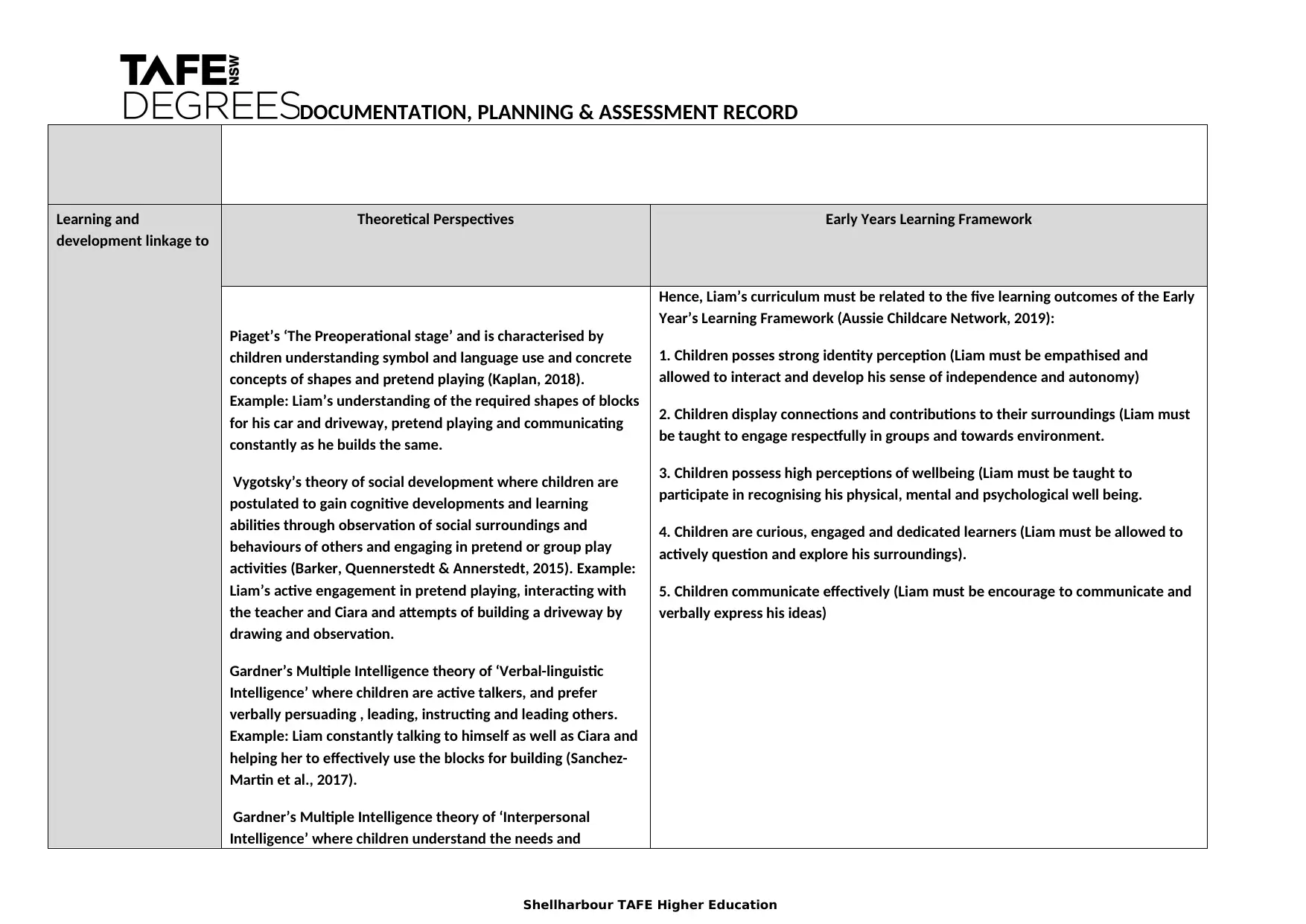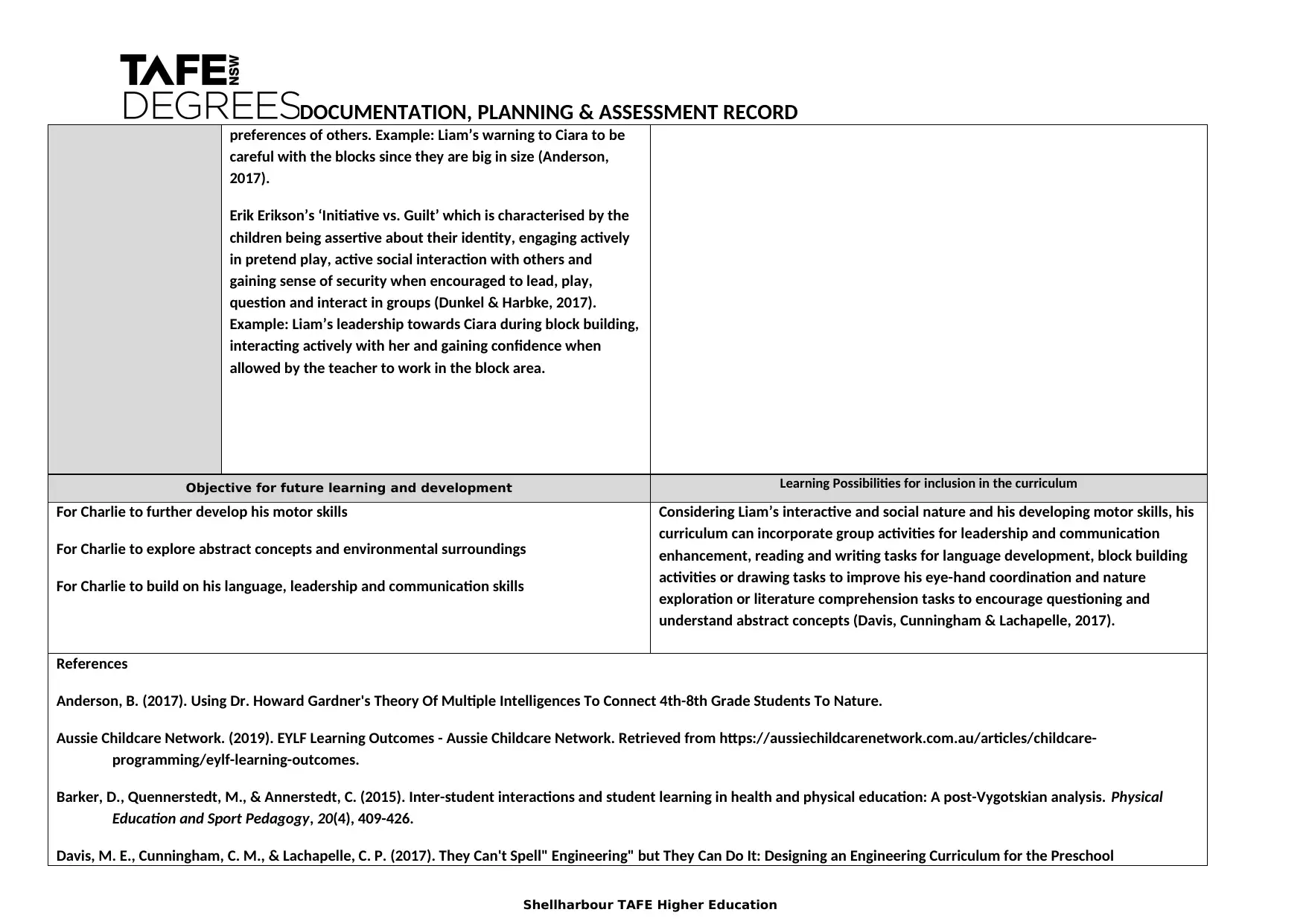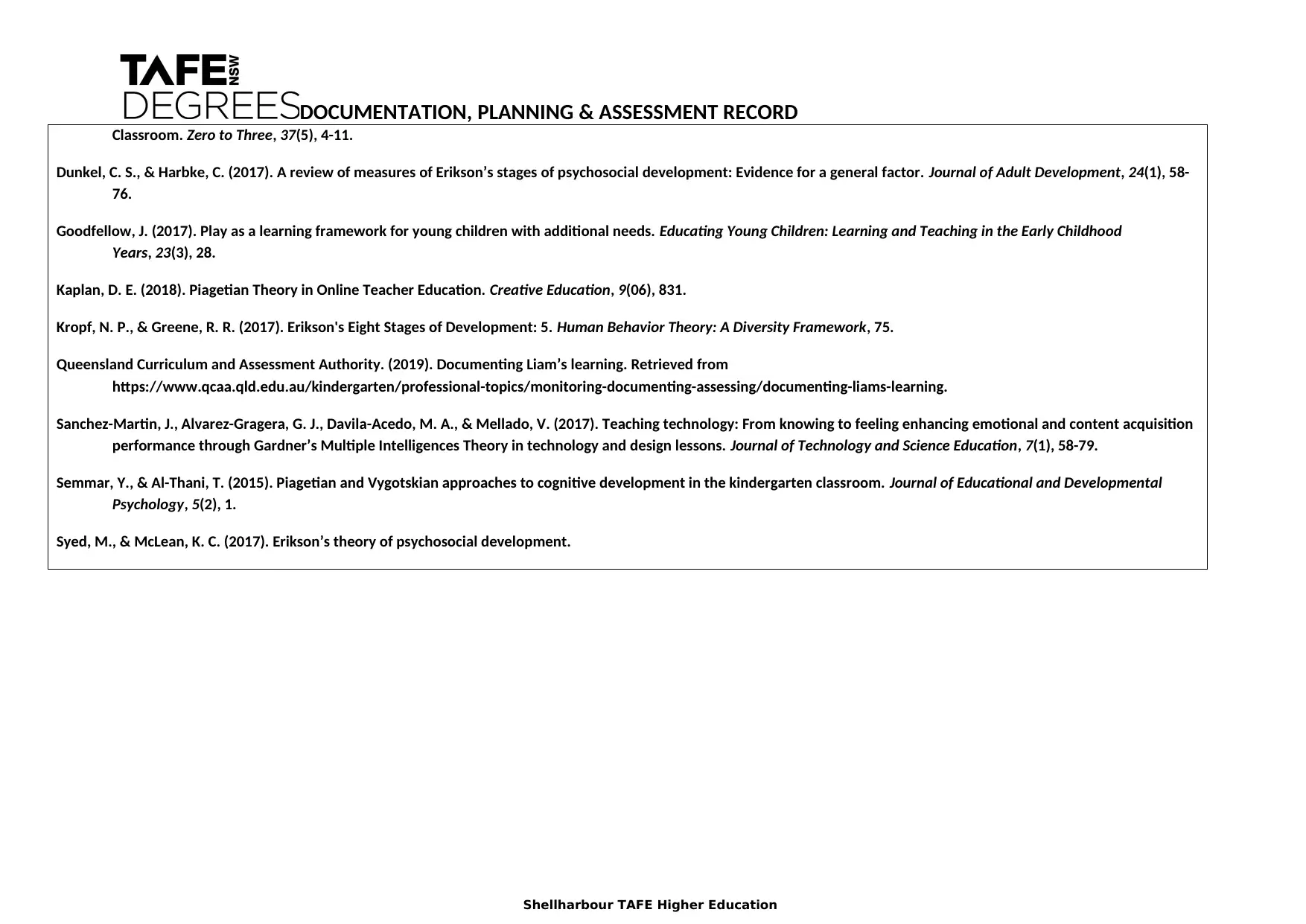Detailed Observation Report: Social Development of a Preschool Child
VerifiedAdded on 2023/04/17
|4
|1282
|54
Report
AI Summary
This report documents and interprets the social development of a preschool child named Liam, observed in a block play scenario. Liam demonstrates a strong sense of self, actively interacts with his peer Ciara, and displays enthusiasm in designing a car and driveway. The interpretation connects Liam's behaviors to Erikson's 'Initiative vs. Guilt' stage and Piaget's 'pre-operational stage,' highlighting his developing social, behavioral, and visual-interpretive skills. The report also links Liam's learning to the Early Years Learning Framework and Gardner’s Multiple Intelligences, suggesting future curriculum possibilities to enhance his motor skills, leadership, communication, and understanding of abstract concepts. The curriculum should incorporate group activities, language development tasks, and nature exploration to encourage questioning and comprehensive learning.

DOCUMENTATION, PLANNING & ASSESSMENT RECORD
Date: Context: Child Name: Age:
Observation:
Running Record
Written like a story in
the present tense.
Describe the behaviour
AS IT HAPPENS. Write
down in detail
everything that occurs.
Time: The video record of Liam was observed and evaluated at 12: 00 PM to 12: 04 PM.
Start:12:00 pm Finish: 12:04 pm
The following observation was about Liam – an active and social learner, who is engaged in designing his car. Noticing that he and Ciara both
displayed an interest towards designing in the block area, both of them are now engaged in building a driveway for Liam’s car on the block of the
learning centre. While young Ciara is facing a little difficulty in coordinating with all the blocks, Liam is not only displaying great energy and skill, but is
also helping and teaching Ciara in doing the same (Queensland Curriculum and Assessment Authority, 2019).
Referenced
Interpretation of the
learning:
Skills and/or
developmental
domains: Comment on
significant
behaviours/skills
Record interests and
strengths and learning
opportunities arising
Liam is observed to demonstrate a strong sense of self, and is evident in his excitement and energy during designing his own care and driveway for the
block area. This is a characteristic feature during the preschool years, as observed in Erikson’s ‘Initiative and Guilt’ stage, where children actively
assert their identity through play (Syed & McLean, 2017). Liam is observed to interact actively with Ciara in helping her build the driveway blocks and
is seen to be very enthusiastic in designing his own driveway and garage for his car. His interaction with Ciara is very positive and cooperative since he
is actively teaching her to use the blocks and encourages her to join him. Not only is he leading Ciara during play but also is initiating further play by
claiming that he needs a big ramp for his car to enter the garage. Liam is observed to visually relate to his surroundings since he claims that he needs a
‘really big’ and ‘very, very good’ ramp for his driveway and warns Ciara of their size when the blocks slip from her hands. Liam’s social, behavioural
and social skills can be related to Erikson’s ‘Initiative and Guilt’s stage where children gain self confidence and security by leading and engaging with
others during play (Kropf & Greene, 2017). Liam is also demonstrating features of Piaget’s ‘pre-operational stage’, by understanding symbolic and
visual concepts and engagement in pretend play (Semmar & Al-Thani, 2015). Liam is seen to engage in building his imaginary driveway and
understand that he needs big blocks for the same. As evident in this stage, Liam’s understanding is still concrete which can be observed in his
realization that using such big blocks for his driveway will be very difficult. Hence, Liam’s eagerness and commendable visual interpretive skills
provides future curriculum opportunities for motor skill improvement, leadership and group coordination (Goodfellow, 2017).
Shellharbour TAFE Higher Education
Date: Context: Child Name: Age:
Observation:
Running Record
Written like a story in
the present tense.
Describe the behaviour
AS IT HAPPENS. Write
down in detail
everything that occurs.
Time: The video record of Liam was observed and evaluated at 12: 00 PM to 12: 04 PM.
Start:12:00 pm Finish: 12:04 pm
The following observation was about Liam – an active and social learner, who is engaged in designing his car. Noticing that he and Ciara both
displayed an interest towards designing in the block area, both of them are now engaged in building a driveway for Liam’s car on the block of the
learning centre. While young Ciara is facing a little difficulty in coordinating with all the blocks, Liam is not only displaying great energy and skill, but is
also helping and teaching Ciara in doing the same (Queensland Curriculum and Assessment Authority, 2019).
Referenced
Interpretation of the
learning:
Skills and/or
developmental
domains: Comment on
significant
behaviours/skills
Record interests and
strengths and learning
opportunities arising
Liam is observed to demonstrate a strong sense of self, and is evident in his excitement and energy during designing his own care and driveway for the
block area. This is a characteristic feature during the preschool years, as observed in Erikson’s ‘Initiative and Guilt’ stage, where children actively
assert their identity through play (Syed & McLean, 2017). Liam is observed to interact actively with Ciara in helping her build the driveway blocks and
is seen to be very enthusiastic in designing his own driveway and garage for his car. His interaction with Ciara is very positive and cooperative since he
is actively teaching her to use the blocks and encourages her to join him. Not only is he leading Ciara during play but also is initiating further play by
claiming that he needs a big ramp for his car to enter the garage. Liam is observed to visually relate to his surroundings since he claims that he needs a
‘really big’ and ‘very, very good’ ramp for his driveway and warns Ciara of their size when the blocks slip from her hands. Liam’s social, behavioural
and social skills can be related to Erikson’s ‘Initiative and Guilt’s stage where children gain self confidence and security by leading and engaging with
others during play (Kropf & Greene, 2017). Liam is also demonstrating features of Piaget’s ‘pre-operational stage’, by understanding symbolic and
visual concepts and engagement in pretend play (Semmar & Al-Thani, 2015). Liam is seen to engage in building his imaginary driveway and
understand that he needs big blocks for the same. As evident in this stage, Liam’s understanding is still concrete which can be observed in his
realization that using such big blocks for his driveway will be very difficult. Hence, Liam’s eagerness and commendable visual interpretive skills
provides future curriculum opportunities for motor skill improvement, leadership and group coordination (Goodfellow, 2017).
Shellharbour TAFE Higher Education
Paraphrase This Document
Need a fresh take? Get an instant paraphrase of this document with our AI Paraphraser

DOCUMENTATION, PLANNING & ASSESSMENT RECORD
Learning and
development linkage to
Theoretical Perspectives Early Years Learning Framework
Piaget’s ‘The Preoperational stage’ and is characterised by
children understanding symbol and language use and concrete
concepts of shapes and pretend playing (Kaplan, 2018).
Example: Liam’s understanding of the required shapes of blocks
for his car and driveway, pretend playing and communicating
constantly as he builds the same.
Vygotsky’s theory of social development where children are
postulated to gain cognitive developments and learning
abilities through observation of social surroundings and
behaviours of others and engaging in pretend or group play
activities (Barker, Quennerstedt & Annerstedt, 2015). Example:
Liam’s active engagement in pretend playing, interacting with
the teacher and Ciara and attempts of building a driveway by
drawing and observation.
Gardner’s Multiple Intelligence theory of ‘Verbal-linguistic
Intelligence’ where children are active talkers, and prefer
verbally persuading , leading, instructing and leading others.
Example: Liam constantly talking to himself as well as Ciara and
helping her to effectively use the blocks for building (Sanchez-
Martin et al., 2017).
Gardner’s Multiple Intelligence theory of ‘Interpersonal
Intelligence’ where children understand the needs and
Hence, Liam’s curriculum must be related to the five learning outcomes of the Early
Year’s Learning Framework (Aussie Childcare Network, 2019):
1. Children posses strong identity perception (Liam must be empathised and
allowed to interact and develop his sense of independence and autonomy)
2. Children display connections and contributions to their surroundings (Liam must
be taught to engage respectfully in groups and towards environment.
3. Children possess high perceptions of wellbeing (Liam must be taught to
participate in recognising his physical, mental and psychological well being.
4. Children are curious, engaged and dedicated learners (Liam must be allowed to
actively question and explore his surroundings).
5. Children communicate effectively (Liam must be encourage to communicate and
verbally express his ideas)
Shellharbour TAFE Higher Education
Learning and
development linkage to
Theoretical Perspectives Early Years Learning Framework
Piaget’s ‘The Preoperational stage’ and is characterised by
children understanding symbol and language use and concrete
concepts of shapes and pretend playing (Kaplan, 2018).
Example: Liam’s understanding of the required shapes of blocks
for his car and driveway, pretend playing and communicating
constantly as he builds the same.
Vygotsky’s theory of social development where children are
postulated to gain cognitive developments and learning
abilities through observation of social surroundings and
behaviours of others and engaging in pretend or group play
activities (Barker, Quennerstedt & Annerstedt, 2015). Example:
Liam’s active engagement in pretend playing, interacting with
the teacher and Ciara and attempts of building a driveway by
drawing and observation.
Gardner’s Multiple Intelligence theory of ‘Verbal-linguistic
Intelligence’ where children are active talkers, and prefer
verbally persuading , leading, instructing and leading others.
Example: Liam constantly talking to himself as well as Ciara and
helping her to effectively use the blocks for building (Sanchez-
Martin et al., 2017).
Gardner’s Multiple Intelligence theory of ‘Interpersonal
Intelligence’ where children understand the needs and
Hence, Liam’s curriculum must be related to the five learning outcomes of the Early
Year’s Learning Framework (Aussie Childcare Network, 2019):
1. Children posses strong identity perception (Liam must be empathised and
allowed to interact and develop his sense of independence and autonomy)
2. Children display connections and contributions to their surroundings (Liam must
be taught to engage respectfully in groups and towards environment.
3. Children possess high perceptions of wellbeing (Liam must be taught to
participate in recognising his physical, mental and psychological well being.
4. Children are curious, engaged and dedicated learners (Liam must be allowed to
actively question and explore his surroundings).
5. Children communicate effectively (Liam must be encourage to communicate and
verbally express his ideas)
Shellharbour TAFE Higher Education

DOCUMENTATION, PLANNING & ASSESSMENT RECORD
preferences of others. Example: Liam’s warning to Ciara to be
careful with the blocks since they are big in size (Anderson,
2017).
Erik Erikson’s ‘Initiative vs. Guilt’ which is characterised by the
children being assertive about their identity, engaging actively
in pretend play, active social interaction with others and
gaining sense of security when encouraged to lead, play,
question and interact in groups (Dunkel & Harbke, 2017).
Example: Liam’s leadership towards Ciara during block building,
interacting actively with her and gaining confidence when
allowed by the teacher to work in the block area.
Objective for future learning and development Learning Possibilities for inclusion in the curriculum
For Charlie to further develop his motor skills
For Charlie to explore abstract concepts and environmental surroundings
For Charlie to build on his language, leadership and communication skills
Considering Liam’s interactive and social nature and his developing motor skills, his
curriculum can incorporate group activities for leadership and communication
enhancement, reading and writing tasks for language development, block building
activities or drawing tasks to improve his eye-hand coordination and nature
exploration or literature comprehension tasks to encourage questioning and
understand abstract concepts (Davis, Cunningham & Lachapelle, 2017).
References
Anderson, B. (2017). Using Dr. Howard Gardner's Theory Of Multiple Intelligences To Connect 4th-8th Grade Students To Nature.
Aussie Childcare Network. (2019). EYLF Learning Outcomes - Aussie Childcare Network. Retrieved from https://aussiechildcarenetwork.com.au/articles/childcare-
programming/eylf-learning-outcomes.
Barker, D., Quennerstedt, M., & Annerstedt, C. (2015). Inter-student interactions and student learning in health and physical education: A post-Vygotskian analysis. Physical
Education and Sport Pedagogy, 20(4), 409-426.
Davis, M. E., Cunningham, C. M., & Lachapelle, C. P. (2017). They Can't Spell" Engineering" but They Can Do It: Designing an Engineering Curriculum for the Preschool
Shellharbour TAFE Higher Education
preferences of others. Example: Liam’s warning to Ciara to be
careful with the blocks since they are big in size (Anderson,
2017).
Erik Erikson’s ‘Initiative vs. Guilt’ which is characterised by the
children being assertive about their identity, engaging actively
in pretend play, active social interaction with others and
gaining sense of security when encouraged to lead, play,
question and interact in groups (Dunkel & Harbke, 2017).
Example: Liam’s leadership towards Ciara during block building,
interacting actively with her and gaining confidence when
allowed by the teacher to work in the block area.
Objective for future learning and development Learning Possibilities for inclusion in the curriculum
For Charlie to further develop his motor skills
For Charlie to explore abstract concepts and environmental surroundings
For Charlie to build on his language, leadership and communication skills
Considering Liam’s interactive and social nature and his developing motor skills, his
curriculum can incorporate group activities for leadership and communication
enhancement, reading and writing tasks for language development, block building
activities or drawing tasks to improve his eye-hand coordination and nature
exploration or literature comprehension tasks to encourage questioning and
understand abstract concepts (Davis, Cunningham & Lachapelle, 2017).
References
Anderson, B. (2017). Using Dr. Howard Gardner's Theory Of Multiple Intelligences To Connect 4th-8th Grade Students To Nature.
Aussie Childcare Network. (2019). EYLF Learning Outcomes - Aussie Childcare Network. Retrieved from https://aussiechildcarenetwork.com.au/articles/childcare-
programming/eylf-learning-outcomes.
Barker, D., Quennerstedt, M., & Annerstedt, C. (2015). Inter-student interactions and student learning in health and physical education: A post-Vygotskian analysis. Physical
Education and Sport Pedagogy, 20(4), 409-426.
Davis, M. E., Cunningham, C. M., & Lachapelle, C. P. (2017). They Can't Spell" Engineering" but They Can Do It: Designing an Engineering Curriculum for the Preschool
Shellharbour TAFE Higher Education
⊘ This is a preview!⊘
Do you want full access?
Subscribe today to unlock all pages.

Trusted by 1+ million students worldwide

DOCUMENTATION, PLANNING & ASSESSMENT RECORD
Classroom. Zero to Three, 37(5), 4-11.
Dunkel, C. S., & Harbke, C. (2017). A review of measures of Erikson’s stages of psychosocial development: Evidence for a general factor. Journal of Adult Development, 24(1), 58-
76.
Goodfellow, J. (2017). Play as a learning framework for young children with additional needs. Educating Young Children: Learning and Teaching in the Early Childhood
Years, 23(3), 28.
Kaplan, D. E. (2018). Piagetian Theory in Online Teacher Education. Creative Education, 9(06), 831.
Kropf, N. P., & Greene, R. R. (2017). Erikson's Eight Stages of Development: 5. Human Behavior Theory: A Diversity Framework, 75.
Queensland Curriculum and Assessment Authority. (2019). Documenting Liam’s learning. Retrieved from
https://www.qcaa.qld.edu.au/kindergarten/professional-topics/monitoring-documenting-assessing/documenting-liams-learning.
Sanchez-Martin, J., Alvarez-Gragera, G. J., Davila-Acedo, M. A., & Mellado, V. (2017). Teaching technology: From knowing to feeling enhancing emotional and content acquisition
performance through Gardner’s Multiple Intelligences Theory in technology and design lessons. Journal of Technology and Science Education, 7(1), 58-79.
Semmar, Y., & Al-Thani, T. (2015). Piagetian and Vygotskian approaches to cognitive development in the kindergarten classroom. Journal of Educational and Developmental
Psychology, 5(2), 1.
Syed, M., & McLean, K. C. (2017). Erikson’s theory of psychosocial development.
Shellharbour TAFE Higher Education
Classroom. Zero to Three, 37(5), 4-11.
Dunkel, C. S., & Harbke, C. (2017). A review of measures of Erikson’s stages of psychosocial development: Evidence for a general factor. Journal of Adult Development, 24(1), 58-
76.
Goodfellow, J. (2017). Play as a learning framework for young children with additional needs. Educating Young Children: Learning and Teaching in the Early Childhood
Years, 23(3), 28.
Kaplan, D. E. (2018). Piagetian Theory in Online Teacher Education. Creative Education, 9(06), 831.
Kropf, N. P., & Greene, R. R. (2017). Erikson's Eight Stages of Development: 5. Human Behavior Theory: A Diversity Framework, 75.
Queensland Curriculum and Assessment Authority. (2019). Documenting Liam’s learning. Retrieved from
https://www.qcaa.qld.edu.au/kindergarten/professional-topics/monitoring-documenting-assessing/documenting-liams-learning.
Sanchez-Martin, J., Alvarez-Gragera, G. J., Davila-Acedo, M. A., & Mellado, V. (2017). Teaching technology: From knowing to feeling enhancing emotional and content acquisition
performance through Gardner’s Multiple Intelligences Theory in technology and design lessons. Journal of Technology and Science Education, 7(1), 58-79.
Semmar, Y., & Al-Thani, T. (2015). Piagetian and Vygotskian approaches to cognitive development in the kindergarten classroom. Journal of Educational and Developmental
Psychology, 5(2), 1.
Syed, M., & McLean, K. C. (2017). Erikson’s theory of psychosocial development.
Shellharbour TAFE Higher Education
1 out of 4
Your All-in-One AI-Powered Toolkit for Academic Success.
+13062052269
info@desklib.com
Available 24*7 on WhatsApp / Email
![[object Object]](/_next/static/media/star-bottom.7253800d.svg)
Unlock your academic potential
Copyright © 2020–2025 A2Z Services. All Rights Reserved. Developed and managed by ZUCOL.


